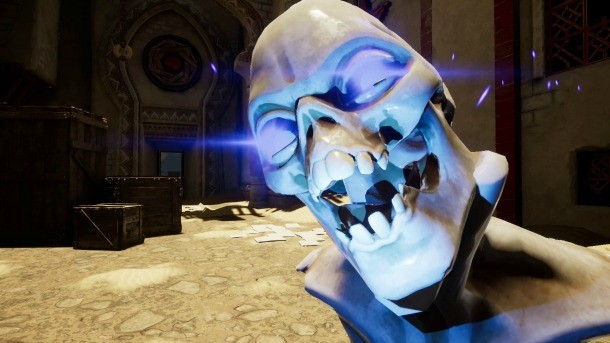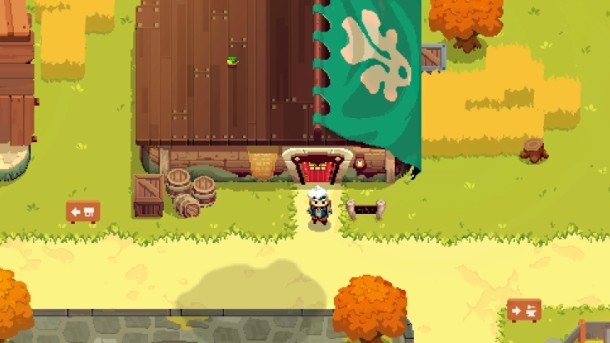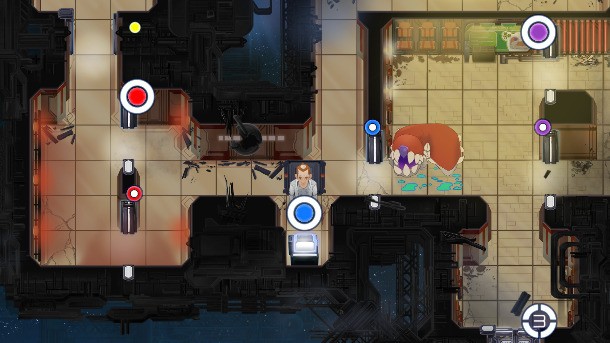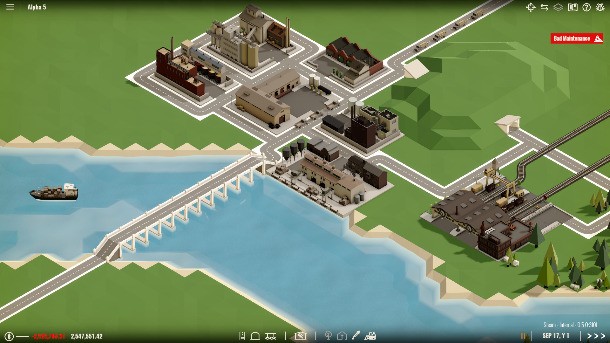Please support Game Informer. Print magazine subscriptions are less than $2 per issue
The Best Indie Games Of GDC 2018

Game Developers Conference features an annual convergence of some of the best minds in the video game industry, and many of them have games to show. GDC typically features a huge slate of independent games, and this year is no different. From the large GDC Play area and The Mix reception to special curated showcases hosted by Nintendo and Microsoft, there is no shortage of independent developers with exciting titles to show off.
Check out the coolest and most interesting indie games the Game Informer crew in attendance at GDC 2018 played during the conference.
Games are listed alphabetically.

Apocalypse Cow
Platform: Xbox One, PC
Developer: Monsters
Release: 2018
Rampaging through a 2D sidescroller always proves fun. We've done it with games like Contra, Metal Slug, and Broforce, and soon players will be able to do it in Apocalypse Cow. This title puts you in the role of Penny as you shoot and slash through areas full of enemies and pop culture references. From pipes that look pulled straight out of Super Mario Bros. to references to Lord of the Rings, there are plenty of nods to nerd culture. The bright and appealing visuals are complemented by the gore and difficulty. Each time you die, a number pops up over your head, taunting you with how many times you've failed. And you will fail a lot. Many of the sequences feature puzzle or bullet-hell elements, but thankfully you have the ability to dramatically slow time. Speeding around slashing enemies in two with your sword while time is mostly frozen is immensely satisfying, and the mechanic is even more rewarding once you finish a level and you get to see how you looked in real-time. –Brian Shea

Bad North
Platform: PS4, Xbox One, Switch, PC, Mac, iOS, Android
Developer: Plausible Concept
Release: Summer
A minimalist strategy game that takes elements from real-time tactical titles as well as the tower defense genre, Bad North is addicting in its simplicity. You begin each stage by placing your units on the procedurally generated island. I had access to infantrymen, archers, and pike soldiers to defend my island. Vikings crash on the shores of my island with the intent of burning houses to the ground. Your job is to place your units in the best position to defend the buildings. If your units start lowering in numbers from being attacked, you can retreat them into the house to replenish over the next several seconds. However, if you remove one of your units from the field of battle even temporarily, things can get out of hand quick. In addition, if the house burns to the ground with a unit inside of it, that unit perishes, and the permadeath mechanic means they won't carry over to the next level. You earn money for each house remaining at the end of the round, and you use that money to upgrade your units. I upgraded my archers to “veteran” status, which made them more accurate, then gave my infantry bombs to deal area-of-effect damage at key points in the battle. –Brian Shea

Batbarian
Platform: Switch, PC, Mac
Developer: Unspeakable Pixels
Release: 2019
Batbarian is the latest in the long line of indie titles that draw heavy inspiration from Metroid and Castlevania. You're in control of a barbarian and his friendly luminescent bat companion as they attempt to escape from a dungeon. As you explore the dungeon, you find new abilities, helpful companions, and, of course, enemies. I was delighted to find a treat that I could use to lure my bat companion to a switch that activates when its illuminated by his natural glow, and after I saved a wizard, I was able to use him to blast fireballs at nearby enemies. Some light RPG elements help you feel true progression. I leveled up twice during my time with Batbarian, and with a slot machine minigame popping up each time. Based on what icons I stopped the slots on, I received new stat boosts. You can also discover secrets that add permanent buffs to traits like strength and defense, which grant immediately noticeable improvements to your character. I enjoyed lurking in the dark, pixelated depths of Batbarian and am excited to see what other secrets are hidden in the game's shadows. –Brian Shea

Below
Platform: Xbox One, PC
Developer: Capybara Games
Release: TBA
This unforgiving action adventure game was first announced around five years ago, and then exited the spotlight for a long time. Now, we finally got a chance to see new gameplay at GDC, and we came away impressed. Below tasks players with delving deeper and deeper into caverns and underground areas. It has gorgeous but oppressive visuals with very little UI, giving it a minimalistic look. This is a different turn for developer Capybara, whose past games (like Super Time Force) had a more colorful and optimistic feel to them. In Below, you're tasked with exploring the depths of the underground and attempting to survive. Enemies, from rats to strange glowing red beings, can ferociously attack at a moment's notice. They can even make you bleed out if you're not careful. Below isn't just about brutal combat, however. It's also about exploring the mysteries of this world and keeping a keen eye on your hunger and thirst. With campfires, you can cook some soup to keep hunger at bay with ingredients you've collected, or cauterize a wound by heating your sword with the flames. Although Capybara has no firm release date for Below just yet, we're looking forward to playing it in full when it arrives. -Elise Favis

Black Future '88
Platform: PC
Developer: SUPERSCARYSNAKES
Release: 2018
One of the benefits of placing retro-style games on modern controllers is that they can leverage not only things like dual-analog sticks, but the years of experience modern players have with them for faster action. That seems to be the ethos behind Black Future, a sidescrolling dual-analog shooter that moves like Strider and looks like Blade Runner. The game is broken up into different vertical rooms with multiple exits and multiple enemies to be defeated before the room can be exited. You're constantly told the route to the boss, but players are free to run around and find new guns before getting to the end of the level, making the game more similar to rogue-lites Binding of Isaac and Enter the Gungeon than any kind of Metroidvania. Climb a tower, kill some bosses, shoot some guns, it's simple enough, but definitely appeals to fans of twitchy sidescrollers like Mega Man Zero. –Imran Khan

Children of Morta
Platform: PS4, Xbox One, Switch, PC
Developer: Dead Mage Inc.
Release: Summer/Fall (Switch TBA)
One of two pixel-art fantasy games being published by 11-Bit Studios, this hack-n-slash roguelike from Dead Mage makes warding off evil a family affair. Players take control of the Bergson family, which has kept watch over Mount Morta for generations. When the mountain erupts with a black tar that corrupts the surrounding animals, as well as the ancient gods who call the range home, the clan must take action. To gain access to the mountain god, they need to activate a portal that can only be Kickstarted by exploring the surrounding regions, rescuing the gods of these areas, and having them lend their power.
Children of Morta employs a mix of procedurally generated dungeons, handcrafted levels, and instanced narrative experiences that create an underlying thread throughout the adventure. When you’re not cutting through hostile territory, the Bergson household serves as a hub where players can get to know the family, some of which can be taken out on adventures and some of which hold down the fort. All told, players can control six of the family members, each of which has different abilities. You can only take one person out on an adventure at a time (or two if you are playing online/local co-op), but similar to Mass Effect all the characters gain experience even if they stay back at the family stead. Each has a couple unique fighting styles that can be swapped out on the fly.
Look for Children of Morta later this year. –Matt Bertz

City of Brass
Platform: PlayStation 4, Xbox One, PC
Developer: Uppercut Games
Release: 2018
City of Brass is a game from Uppercut Games, a studio comprised of ex-BioShock developers. This roguelite is set in an Arabian Nights-themed city, where you attempt to make your way further and further each playthrough. The city is procedurally generated, and filled with both deadly traps and the undead. With your whip, you can disarm enemies, as well as pull them into traps. You can also use your scimitar to deal deadly damage to these foes. I enjoyed the fluidity of the combat and how my whip was also a tool to help me access treasure that was previously out of reach. As you collect treasure, you gain more currency, which can be used to buy upgrades as you delve deeper into the city. City of Brass is a difficult game, but I enjoyed the challenge as well as the satisfying combat. –Elise Favis

Descenders
Platform: PS4, Xbox One, Switch, PC
Developer: RageSquid
Release: Late 2018/Early 2019
Fans of the Trials series will likely want to watch out for Descenders. This 3D mountain biking title feels like the spiritual leap to the next level for the genre ruled primarily by that popular series. The pretty graphics and simple controls make it approachable for anyone, but once you hit the more difficult courses, you'll get a full demonstration of the ragdoll physics. Much like Trials, hitting a ramp, pull a backflip, and landing cleanly feels great, but you had better complete your rotation or else you'll come crashing down. Campaign mode provides a more robust experience for players, but I was immediately drawn to the freeride mode, which allowed me to customize every aspect of the course from weather and time of day to how much curvature and steepness I wanted in my track. Descenders is currently available on Steam Early Access and will be coming to Xbox One Game Preview this May before a late 2018/early 2019 1.0 release. -Brian Shea

Kids
Platform: PC, Mac, iOS, Android
Developer: Playables
Release: 2018
When Kids was showcased at Day of the Devs, you could sense the surprise and confusion in the audience. Some laughed at the quirky, weird moments and many applauded once the presentation was over. Kids is an experimental game about crowds. You progress the game by clicking or tapping hordes of faceless, vaguely drawn black-and-white humans. Kids is the second collaboration between director and animator Michael Frei and game designer Mario von Rickenbach, following their previous game Plug & Play. Your task is to progress different scenes by clicking on the beings or guiding them to different areas. This includes one scene starting off with a being stating, "no one likes me," and then tasks you with making your way through a large crowd as every other being circles and avoids you. In another scene, a dozen beings points to one human who says, "I won't do it." Interacting here causes them to point at someone else until they finally find a willing volunteer. Other scenes just show masses of these beings jumping into a black hole. It's difficult to sum up exactly why Kids is so special, but it left me thinking about the game long after the presentation ended. It felt like it tapped into the psychology of crowds, and of the significance (or insignificance) of individualism. It was both intriguing and dizzying to see hundreds of these beings run across the screen, leaving me with a sense of wonder. Kids will release in three formats: as a game, as an art exhibition, and a short film. –Elise Favis

Moonlighter
Platform: PS4, Xbox One, Switch, PC, Mac
Developer: Digital Sun
Release: 2018
Playing as a shopkeeper by day and a hero by night, Moonlighter uniquely mixes two very different elements into one. Protagonist Will runs a modest store in a small village, but dreams of being something more. You spend time managing your shop and collecting raw goods from deep inside dangerous areas ravaged by monsters. Making your way through these locations with hack n slash combat, you eventually bring back materials to sell in your shop. From there, you can set up what you think are reasonable prices for your items and then open the doors to the public. Customers will peruse your displays and shelves, and will have varying reactions depending on the price levels you chose. Gauging the correct price can make your shop more successful, and eventually lead you towards upgrading your storefront to make it more appealing to clientele and more efficient for you, such as more space to store things. Even the town as a whole can be upgraded through the town board, where you can recruit new merchants. For example, if you can get the retailer to move into town, he can restore your items if you lost them while dungeon crawling. As for quests, they aren't only found in dungeons. Villagers also have their own stories and requests for you to complete. Moonlighter is a charming title, with a pleasant pixel aesthetic and an interesting mix of gameplay elements that helps it stand out. –Elise Favis

Mosaic
Platform: PS4, Xbox One, PC, Mac
Developer: Killbite Studio
Release: 2018
From the developers of Among the Sleep, a horror game from the perspective of a toddler, comes a very different title called Mosaic. In Mosaic, you play as a businessman in a corporate dystopia on his way to work. Inspired by the short, experimental flash game Every Day the Same Dream, Mosaic is all about your repetitive and monotonous commute, but strange occurrences start to happen. You may notice a mysterious red glow beyond a gate left ajar near a construction site. Or maybe you take control of a butterfly briefly in a dream-like sequence. Other times, you just soak in the environment around you with little distractions like a cat running off or crossing a bridge above a swarm of motionless cars stuck in traffic, with hundreds of headlights glowing. The environments often have a blue hue, and humans are tall, lanky, and mute. It gives a somber and oppressive feel to the game and the brilliant art direction makes each area captivating. –Elise Favis

Phantom Doctrine
Platform: PS4, Xbox One, PC
Developer: CreativeForge Games
Release: 2018
Fans of XCOM will definitely want to check out Phantom Doctrine from CreativeForge games. A tactical, turn-based strategy game has terrific production values and an ambitious design. The game centers on running a spy agency during the Cold War. You can send your agents on missions across the globe, with certain skillsets giving them a better chance at success. As your agents get more experience under their belts, you can train them to be better at various tasks. If you capture a rival spy, you can perform MK Ultra tasks on them like interrogation, brainwashing, or installing trigger words to use on them down the road to make them flip their loyalty to you when the time is right. The downside to these abilities is that anything you can do, your enemies can do as well. Hire someone without properly vetting them? You could invite a mole into your agency. Send an agent on a mission and they're acting suspicious upon return? They may have been secretly brainwashed during their trip. In addition, if your enemies spot one of your agents, they are no longer able to go on covert operations until you assign them a new identity.
Once you're in the tactical battles, things play out much like they do in the recent XCOM games; you move your agents around the enemies and if things escalate, you can take out your enemies with your arsenal of firearms. However, some key differences exist in Phantom Doctrine. First, you can often complete these turn-based missions 100 percent in stealth. In the mission I experienced, my agents entered into the field in civilian clothes and didn't draw the attention of the guards until I opened fire on one of them. After that, firefights play out similar to XCOM, but without the RNG factor. Rather than seeing a percentage, you see a minimum and maximum amount of damage. Several factors (like your agent's awareness, your target's awareness, how obstructed the shot is, distance, weapon you're using, etc) go into how effective each attack is, but you should have an idea of how effective your attack is going to be prior to setting things into action. You can also call agents from outside of the field to help you out with things like snipers or grenades. Again, however, anything you can do, your opponent can also do. In my case, my enemies had a more powerful attack: an airstrike.
With so many unpredictable factors at play, as well as a deep agency management mechanic, I can't wait to play the full version and see just how deep the well goes with Phantom Doctrine. –Brian Shea

Professor Lupo and His Horrible Pets
Platform: Switch, PC, Mac, Linux, iOS, Android
Developer: BeautiFun Games
Release: Summer (PC, Mac, Linux, iOS, Android), Fall (Switch)
The eccentric Professor Lupo has summoned the dictators and conquerors of the world to his remote space station in order to auction off dangerous monsters they can use in future wars. However, the station proves to be too enticing a target for some unknown attacker, as missiles strike the space station during a demonstration and the killer monsters are set loose. You assume the role of an intern on the space station as you try to escape the loose monsters. From the top-down perspective, you guide the poor intern through the areas of the space station in this puzzle/action title. Each stage features a clear destination, but with various terminals that open different doors with the potential to set monsters loose, things can go very wrong very quick. On multiple occasions, I threw the wrong switch, and the intern became lunch for a beast. The stages are packed with seven distinct types of monsters, with abilities like being able to bash down doors or latch onto nearby surfaces to close the distance quickly. Stages also sometimes feature NPCs that you can either put yourself in danger to save or choose to ignore and seal their fates. Professor Lupo and His Horrible Pets features 100 levels. Each stage features collectibles and a hard mode that can be toggled at the start, but with so many factors in play with a standard stage, I was happy to keep it on normal. –Brian Shea

Rend
Platform: PC
Developer: Frostkeep Studios
Release: TBA
The survival sim genre is well-trodden ground in the land of early access, but Frostkeep Studios is trying to elevate it to a higher plane. Rend, a survival game built on Epic's Unreal Engine 4 engine, shakes things up by trying to redefine isolation to be less about the player and more about your tribe. Players start the game by choosing one of three factions to align with, establishing a home base within a team of twenty people. This prevents players from the normal survival problem of waking up naked and alone on an island with no defenses only to be taken down by another player far more experienced than yourself. Factions establish their fortresses and go out together to collect souls from powerful monsters and quests, then store them in the fortresses which are usually shielded by a barrier. Those barriers go down at set intervals that are publicized ahead of time and allow for factions to go to war with each other, to either steal or defend their souls, and change the balance of the game. When a faction has enough souls, they make their way to the center of the continent and engage in trials to ultimately win, which resets the server, provides bonuses to take into the next game, and gives them some items to play around with before the server reset. Alongside its tight shooter gameplay and a sense of scale that intentionally seems to invoke Xenoblade, the game seems to be making interesting changes and has shared stakes that I have wanted from online survival games since their inception. Rend is coming to early access on Steam later this year and Frostkeep says they are exploring consoles as an option. –Imran Khan

Rise of Industry
Platform: PC, Linux
Developer: Dapper Penguin Studios
Release: Late 2018
Rise of Industry takes inspiration from major simulation franchises like SimCity and Tropico to deliver an industry-focused experience that will have you questioning your every business decision. Unlike other sim-based games, Rise of Industry gives you one goal: develop your region to be a highly profitable, industrial area. Of course, it's not as simple as it sounds. In order to achieve those goals, you must keep the citizens happy so they don't boycott your products or even block you from building in their area. Instead of being a tyrant, you must establish a symbiotic relationship with the citizens of the region you're developing. As you progress through the game, you unlock new specialties through an RPG-style tree. Like the Civilization series, you can invest more money into these research projects to speed up their progress. Currently, you can play with limited funds in campaign mode, unlimited funds in free play, and customize every aspect of the land mass in custom games. Before launch, developer Dapper Penguin Studios plans on adding scenarios to complete in order to give you additional challenges. Following launch, Rise of Industry will introduce both cooperative and competitive multiplayer modes as a free update. In fact, the developer tells me that all functional updates will be free of charge (cosmetic updates, like one that themes the world through a cyberpunk lens, may cost extra). With a highly customizable experience focused on becoming a titan of industry, as well as a development team devoted to fulfilling the promises made in its robust roadmap and reacting to player feedback, Rise of Industry is one for simulation fans to watch for. –Brian Shea

Sinner: Sacrifice for Redemption;
Platform: PC, PlayStation 4, Xbox One
Developer: Dark Star
Release: April 25
The seven deadly sins have long been used in fiction as fodder for different kinds of abstract and literal concepts, often used as video game enemies. Sinner: Sacrifice for Redemption, a game that takes heavy inspiration from Dark Souls, is structured as a boss rush title where the player character defeats bosses inspired by the seven deadly sins. Lust, for example, is a hyper-aggressive Bloodborne-style boss who uses dual-blades and a bow to keep pressure on your character. That in and of itself can be fairly difficult, but the "Sacrifice" part of the title comes into play when each boss, upon victory, requires your character to lose a part of themselves to continue on. One boss requires you to sacrifice your defense, forcing you into the next boss fight with no armor, meaning dodging becomes far more paramount. Sinner: Sacrifice for Redemption is coming to PlayStation 4, Xbox One, and Steam but the developer hasn't closed the door on Switch. –Imran Khan

Super Daryl Deluxe
Platform: PS4, Switch, PC
Developer: Dan & Gary Games
Release: April 10
Described as an "RPGvania," Super Daryl Deluxe combines the Metroid-inspired level design with a deep role-playing upgrade and quest system and tosses it into a blender with brawler-style combat. You assume the role of Daryl, a new kid at a high school. He's struggling to fit in, but a mystery soon presents itself and for reasons unknown to him, he's the one who has to save the world. Each classroom in the high school plays the role of a dungeon in a typical RPG, with that area themed after the subject taught in that room. For example, in the history room, I ran into Napoleon Bonaparte. The hand-drawn art style is appealing at first glance and complements the eclectic soundtrack well. During my time with Super Daryl Deluxe, I battled my way through legions of enemies using my custom loadout. Each ability is able to be upgraded as you progress; my chargeable hammer smash was upgraded to a rhino on a stick when maxed out. You can swap your loadout to suit your playstyle. For one quest, I wanted to use magic-based attacks, so I built Daryl's loadout to feature laser cannons and meteors. As I played on, I felt drawn to the hack-and-slash style, so I equipped melee abilities with short cooldowns. I had a fun time with Super Daryl Deluxe, and thankfully we don't have to wait long to play the full experience (which I'm told is upwards of 20 hours), as the game hits PS4, Switch, and PC next month. –Brian Shea

The Messenger
Platform: Switch, PC
Developer: Sabotage
Release: Summer
Ninja Gaiden inspiration abounds with The Messenger from Sabotage. With smooth controls and difficult platforming challenges, The Messenger plays like an 8-bit love letter to the classic NES title. However, it becomes so much more than an 8-bit love letter once you get a bit deeper into the game, as you flash forward 500 years into the future. To reflect this passage of time, the graphics and music changes to 16-bit, and the game's design changes to the Metroid and Castlevania style. The game actually runs both versions of the game simultaneously, so puzzles that require bouncing back and forth between graphical styles present themselves. Much like the beloved “Effect and Cause” stage from Titanfall 2, some paths and enemies are only accessible in one graphical style, so you have to be clever with how you swap between the two. The Messenger is sure to please both fans of Ninja Gaiden and Metroid when it launches this year. –Brian Shea

Untitled Goose Game
Platform: PC
Developer: House House
Release: 2018
The makers of Push Me Pull You continue their quest for making quirky games with this hilarious title that puts players in control of a mischievous goose wreaking havoc on an unassuming town. The demo we watched pitted the public nuisance against a poor groundskeeper just trying to get his work done. The goose dragged his picnic basket and sandwich into the pond, ran around with his radio player in his beak during a Benny Hill-esque chase sequence, turned on a nearby sprinkler to soak the man, and even stole the keys off his belt. It looks as strange as it sounds, but there’s something darkly comic and alluring about taking control of this dastardly goose. –Matt Bertz

What The Golf?
Platform: PC, Mac
Developer: Triband
Release: 2018
Golfing straight up the fairway is ideal, but let’s be honest. It’s also boring. Developer Triband has other ideas for spicing up the sport with this inventive take that challenges preconceptions and has fun breaking the concept with unexpected twists. Maybe instead of firing the golfball in the intended direction after you line up the shot, the golfer gets catapulted toward the pin instead. What if the golfball is replaced by a house or soccer ball? And in perhaps the best twist of all, what would golf be like if it followed the design rules of Superhot? Throughout the frenzied demo, Triband continued to throw clever twists our way, and I’m excited to see what other hijinks they come up with. What the Golf? is currently running a crowdfunding campaign on Fig. You can download a demo of the game here. –Matt Bertz










